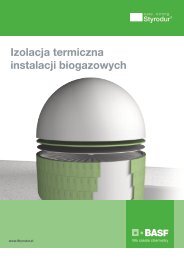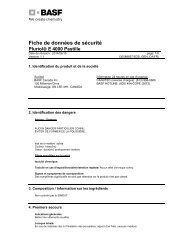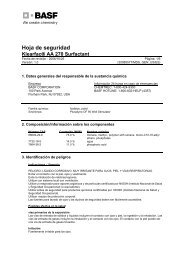Safety Data Sheet
Safety Data Sheet Basonat - WorldAccount - BASF.com
Safety Data Sheet Basonat - WorldAccount - BASF.com
You also want an ePaper? Increase the reach of your titles
YUMPU automatically turns print PDFs into web optimized ePapers that Google loves.
<strong>Safety</strong> <strong>Data</strong> <strong>Sheet</strong><br />
Basonat HW 2000 (old Basonat® LR 9056)<br />
Revision date : 2015/05/29 Page: 1/10<br />
Version: 3.0<br />
(30397381/SDS_GEN_CA/EN)<br />
1. Identification<br />
Product identifier used on the label<br />
Basonat® HW 2000 (old Basonat® LR 9056)<br />
Recommended use of the chemical and restriction on use<br />
* The “Recommended use” identified for this product is provided solely to comply with a Federal requirement and is not part of<br />
the seller's published specification. The terms of this <strong>Safety</strong> <strong>Data</strong> <strong>Sheet</strong> (SDS) do not create or infer any warranty, express or<br />
implied, including by incorporation into or reference in the seller's sales agreement.<br />
Details of the supplier of the safety data sheet<br />
Company:<br />
BASF Canada Inc.<br />
100 Milverton Drive<br />
Mississauga, ON L5R 4H1, CANADA<br />
Telephone: +1 289 360-1300<br />
Emergency telephone number<br />
CANUTEC (reverse charges): (613) 996-6666<br />
BASF HOTLINE: (800) 454-COPE (2673)<br />
Other means of identification<br />
2. Hazards Identification<br />
According to Hazardous Products Regulations (HPR) (SOR/2015-17)<br />
Classification of the product<br />
Acute Tox. 4 (Inhalation - vapour) Acute toxicity<br />
Skin Sens. 1 Skin sensitization<br />
STOT SE<br />
3 (irritating to<br />
Specific target organ toxicity — single exposure<br />
respiratory system)<br />
Aquatic Acute 3 Hazardous to the aquatic environment - acute<br />
Aquatic Chronic 3 Hazardous to the aquatic environment - chronic<br />
Label elements<br />
Pictogram:
<strong>Safety</strong> <strong>Data</strong> <strong>Sheet</strong><br />
Basonat HW 2000 (old Basonat® LR 9056)<br />
Revision date : 2015/05/29 Page: 2/10<br />
Version: 3.0<br />
(30397381/SDS_GEN_CA/EN)<br />
Signal Word:<br />
Warning<br />
Hazard Statement:<br />
H332<br />
H317<br />
H335<br />
H402<br />
H412<br />
Harmful if inhaled.<br />
May cause an allergic skin reaction.<br />
May cause respiratory irritation.<br />
Harmful to aquatic life.<br />
Harmful to aquatic life with long lasting effects.<br />
Precautionary Statements (Prevention):<br />
P280<br />
Wear protective gloves.<br />
P271<br />
Use only outdoors or in a well-ventilated area.<br />
P260<br />
Do not breathe mist or vapour.<br />
P261<br />
Avoid breathing vapours.<br />
P273<br />
Avoid release to the environment.<br />
P272<br />
Contaminated work clothing should not be allowed out of the workplace.<br />
Precautionary Statements (Response):<br />
P312<br />
Call a POISON CENTER or doctor/physician if you feel unwell.<br />
P304 + P340<br />
IF INHALED: Remove person to fresh air and keep comfortable for<br />
breathing.<br />
P303 + P352<br />
IF ON SKIN (or hair): Wash with plenty of soap and water.<br />
P333 + P311<br />
If skin irritation or rash occurs: Call a POISON CENTER or<br />
doctor/physician.<br />
P362 + P364<br />
Take off contaminated clothing and wash before reuse.<br />
Precautionary Statements (Storage):<br />
P403 + P233<br />
Store in a well-ventilated place. Keep container tightly closed.<br />
P405<br />
Store locked up.<br />
Precautionary Statements (Disposal):<br />
P501<br />
Dispose of contents/container to hazardous or special waste collection<br />
point.<br />
Hazards not otherwise classified<br />
No specific dangers known, if the regulations/notes for storage and handling are considered.<br />
According to Controlled Products Regulations (CPR) (SOR/88-66)<br />
Emergency overview<br />
SENSITIZER.<br />
Danger of skin sensitization on repeated contact.<br />
May cause respiratory irritation.<br />
3. Composition / Information on Ingredients<br />
According to Hazardous Products Regulations (HPR) (SOR/2015-17)<br />
CAS Number Weight % Chemical name
<strong>Safety</strong> <strong>Data</strong> <strong>Sheet</strong><br />
Basonat HW 2000 (old Basonat® LR 9056)<br />
Revision date : 2015/05/29 Page: 3/10<br />
Version: 3.0<br />
(30397381/SDS_GEN_CA/EN)<br />
822-06-0 >= 0.1 - < 0.3% 1,6-hexamethylene diisocyanate<br />
28182-81-2 >= 50.0 - < 75.0% Hexamethylene diisocyanate, isocyanurate-type oligomers<br />
143472-08-6 >= 20.0 - < 35.0% Poly(oxy-1,2-ethanediyl), .alpha.-methyl-.omega.-hydroxy-,<br />
polymer with 1,6-diisocyanatohexane, block<br />
4. First-Aid Measures<br />
Description of first aid measures<br />
General advice:<br />
Immediately remove contaminated clothing.<br />
If inhaled:<br />
If difficulties occur after vapour/aerosol has been inhaled, remove to fresh air and seek medical<br />
attention.<br />
If on skin:<br />
Wash affected areas thoroughly with soap and water. Seek medical attention.<br />
If in eyes:<br />
Wash affected eyes for at least 15 minutes under running water with eyelids held open. If irritation<br />
develops, seek medical attention.<br />
If swallowed:<br />
Immediately rinse mouth and then drink plenty of water, do not induce vomiting, seek medical<br />
attention. Never induce vomiting or give anything by mouth if the victim is unconscious or having<br />
convulsions.<br />
Most important symptoms and effects, both acute and delayed<br />
Symptoms: The most important known symptoms and effects are described in the labelling (see<br />
section 2) and/or in section 11., Further important symptoms and effects are so far not known.<br />
Indication of any immediate medical attention and special treatment needed<br />
Note to physician<br />
Treatment:<br />
Treat according to symptoms (decontamination, vital functions), no<br />
known specific antidote.<br />
5. Fire-Fighting Measures<br />
Extinguishing media<br />
Suitable extinguishing media:<br />
water spray, dry powder, foam<br />
Unsuitable extinguishing media for safety reasons:<br />
water jet<br />
Special hazards arising from the substance or mixture<br />
Hazards during fire-fighting:<br />
harmful vapours
<strong>Safety</strong> <strong>Data</strong> <strong>Sheet</strong><br />
Basonat HW 2000 (old Basonat® LR 9056)<br />
Revision date : 2015/05/29 Page: 4/10<br />
Version: 3.0<br />
(30397381/SDS_GEN_CA/EN)<br />
Evolution of fumes/fog. The substances/groups of substances mentioned can be released in case of<br />
fire.<br />
Advice for fire-fighters<br />
Protective equipment for fire-fighting:<br />
Firefighters should be equipped with self-contained breathing apparatus and turn-out gear.<br />
Further information:<br />
The degree of risk is governed by the burning substance and the fire conditions. Contaminated<br />
extinguishing water must be disposed of in accordance with official regulations.<br />
6. Accidental release measures<br />
Personal precautions, protective equipment and emergency procedures<br />
Use personal protective clothing.<br />
Environmental precautions<br />
Do not discharge into drains/surface waters/groundwater.<br />
Methods and material for containment and cleaning up<br />
Spills should be contained, solidified, and placed in suitable containers for disposal.<br />
7. Handling and Storage<br />
Precautions for safe handling<br />
Keep away from sources of ignition - No smoking.<br />
Protection against fire and explosion:<br />
Take precautionary measures against static discharges.<br />
Conditions for safe storage, including any incompatibilities<br />
Further information on storage conditions: Keep container tightly closed and in a cool place. Keep<br />
container dry.<br />
Storage stability:<br />
If moisture enters isocyanate containers, CO2 forms and pressure builds up.<br />
Protect from temperatures above: 50 °C<br />
8. Exposure Controls/Personal Protection<br />
Components with occupational exposure limits<br />
1,6-hexamethylene<br />
diisocyanate ACGIH TLV TWA value 0.005 ppm ;<br />
Personal protective equipment<br />
Respiratory protection:<br />
Wear a NIOSH-certified (or equivalent) organic vapour/particulate respirator.<br />
Hand protection:<br />
Chemical resistant protective gloves
<strong>Safety</strong> <strong>Data</strong> <strong>Sheet</strong><br />
Basonat HW 2000 (old Basonat® LR 9056)<br />
Revision date : 2015/05/29 Page: 5/10<br />
Version: 3.0<br />
(30397381/SDS_GEN_CA/EN)<br />
Eye protection:<br />
<strong>Safety</strong> glasses with side-shields. Wear face shield if splashing hazard exists.<br />
Body protection:<br />
Impermeable protective clothing<br />
General safety and hygiene measures:<br />
Handle in accordance with good industrial hygiene and safety practice. Wash soiled clothing<br />
immediately.<br />
9. Physical and Chemical Properties<br />
Form:<br />
liquid<br />
Odour:<br />
faint specific odour<br />
Odour threshold:<br />
not determined<br />
Colour:<br />
colourless to yellowish<br />
pH value:<br />
not applicable<br />
Melting point: approx. -46 °C (DIN 51583)<br />
Boiling point:<br />
not determined<br />
Flash point: 168 °C (DIN EN 22719; ISO<br />
2719)<br />
Flammability:<br />
not flammable<br />
Lower explosion limit: As a result of our experience with this<br />
product and our knowledge of its<br />
composition we do not expect any<br />
hazard as long as the product is used<br />
appropriately and in accordance with<br />
the intended use.<br />
Upper explosion limit: As a result of our experience with this<br />
product and our knowledge of its<br />
composition we do not expect any<br />
hazard as long as the product is used<br />
appropriately and in accordance with<br />
the intended use.<br />
Autoignition: 414 °C (DIN EN 14522)<br />
Vapour pressure:<br />
< 0.0001 hPa<br />
( 20 °C)<br />
Density:<br />
1.16 g/cm3<br />
( 20 °C)<br />
1.14 g/cm3<br />
( 50 °C)<br />
Relative density: 1.16<br />
( 20 °C)<br />
Vapour density:<br />
not determined<br />
Partitioning coefficient n- Study scientifically not justified.<br />
octanol/water (log Pow):<br />
Self-ignition<br />
not self-igniting<br />
temperature:<br />
Thermal decomposition: No decomposition if used correctly.<br />
Viscosity, dynamic: 1,500 - 3,000 mPa.s<br />
(DIN EN ISO 3219)<br />
( 23 °C)<br />
Particle size:<br />
The substance / product is marketed<br />
or used in a non solid or granular<br />
form.<br />
Solubility in water:<br />
Reacts with water.<br />
Miscibility with water: Reacts with water.
<strong>Safety</strong> <strong>Data</strong> <strong>Sheet</strong><br />
Basonat HW 2000 (old Basonat® LR 9056)<br />
Revision date : 2015/05/29 Page: 6/10<br />
Version: 3.0<br />
(30397381/SDS_GEN_CA/EN)<br />
Solubility (qualitative):<br />
Evaporation rate:<br />
10. Stability and Reactivity<br />
Reactivity<br />
Oxidizing properties:<br />
not fire-propagating<br />
soluble<br />
solvent(s): polar solvents,<br />
not determined<br />
Chemical stability<br />
The product is stable if stored and handled as prescribed/indicated.<br />
Possibility of hazardous reactions<br />
Reacts with alcohols. Reacts with amines. Reacts with substances which contain active hydrogen.<br />
Reacts with water, with formation of carbon dioxide. The formation of gaseous decomposition<br />
products builds up pressure in tightly closed containers.<br />
Conditions to avoid<br />
Avoid moisture. Avoid humidity. Avoid direct contact with water.<br />
Incompatible materials<br />
water, alcohols, amines<br />
Hazardous decomposition products<br />
Decomposition products:<br />
Hazardous decomposition products: No hazardous decomposition products if stored and handled as<br />
prescribed/indicated.<br />
Thermal decomposition:<br />
No decomposition if used correctly.<br />
11. Toxicological information<br />
Primary routes of exposure<br />
Routes of entry for solids and liquids are ingestion and inhalation, but may include eye or skin<br />
contact. Routes of entry for gases include inhalation and eye contact. Skin contact may be a route<br />
of entry for liquefied gases.<br />
Acute Toxicity/Effects<br />
Acute toxicity<br />
Information on: 1,6-hexamethylene diisocyanate<br />
Assessment of acute toxicity:Of high toxicity after short-term inhalation. In animal studies the<br />
substance is virtually nontoxic after a single skin contact. Of moderate toxicity after single ingestion.<br />
----------------------------------<br />
Oral<br />
Type of value: LD50<br />
Species: rat<br />
Value: > 2,000 mg/kg
<strong>Safety</strong> <strong>Data</strong> <strong>Sheet</strong><br />
Basonat HW 2000 (old Basonat® LR 9056)<br />
Revision date : 2015/05/29 Page: 7/10<br />
Version: 3.0<br />
(30397381/SDS_GEN_CA/EN)<br />
The product has not been tested. The statement has been derived from the properties of the<br />
individual components.<br />
Inhalation<br />
Type of value: LC50<br />
Species: rat<br />
Value: > 1 - 5 mg/l<br />
Exposure time: 4 h<br />
Determined for vapor The product has not been tested. The statement has been derived from the<br />
properties of the individual components.<br />
Dermal<br />
Type of value: LD50<br />
Species: rat<br />
not determined<br />
Skin<br />
Species: rabbit<br />
Result: non-irritant<br />
Method: OECD Guideline 404<br />
The product has not been tested. The statement has been derived from the properties of the<br />
individual components.<br />
Eye<br />
Species: rabbit<br />
Result: non-irritant<br />
Method: OECD Guideline 405<br />
The product has not been tested. The statement has been derived from the properties of the<br />
individual components.<br />
Sensitization<br />
Information on: 1,6-hexamethylene diisocyanate<br />
Assessment of sensitization:<br />
The substance may cause sensitization of the respiratory tract. Sensitization after skin contact<br />
possible.<br />
----------------------------------<br />
Guinea pig maximization test<br />
Result: sensitizing<br />
sensitizing effect in animal tests The product has not been tested. The statement has been derived<br />
from the properties of the individual components.<br />
Chronic Toxicity/Effects<br />
Symptoms of Exposure<br />
The most important known symptoms and effects are described in the labelling (see section 2)<br />
and/or in section 11., Further important symptoms and effects are so far not known.<br />
Medical conditions aggravated by overexposure<br />
The isocyanate component is a respiratory sensitizer. It may cause allergic reaction leading to<br />
asthma-like spasms of the bronchial tubes and difficulty in breathing. Persons with asthmatic<br />
conditions, chronic bronchitis, other chronic respiratory diseases, recurrent eczema or pulmonary<br />
sensitization should be excluded from working with isocyanates. Once a person is diagnosed as<br />
having pulmonary sensitization (allergic asthma) to isocyanates, further exposure is not<br />
recommended.
<strong>Safety</strong> <strong>Data</strong> <strong>Sheet</strong><br />
Basonat HW 2000 (old Basonat® LR 9056)<br />
Revision date : 2015/05/29 Page: 8/10<br />
Version: 3.0<br />
(30397381/SDS_GEN_CA/EN)<br />
12. Ecological Information<br />
Toxicity<br />
Aquatic toxicity<br />
Assessment of aquatic toxicity:<br />
The inhibition of the degradation activity of activated sludge is not anticipated when introduced to<br />
biological treatment plants in appropriate low concentrations.<br />
Toxicity to fish<br />
LC50 (96 h), Fish<br />
not determined<br />
Aquatic invertebrates<br />
EC50 (48 h) 10 - 100 mg/l, Daphnia magna<br />
The product has not been tested. The statement has been derived from substances/products of a<br />
similar structure or composition.<br />
Aquatic plants<br />
EC50 (72 h), algae<br />
not determined<br />
Chronic toxicity to fish<br />
No data available.<br />
Chronic toxicity to aquatic invertebrates<br />
No data available.<br />
Assessment of terrestrial toxicity<br />
Study scientifically not justified.<br />
Microorganisms/Effect on activated sludge<br />
Toxicity to microorganisms<br />
bacteria/EC50 (3 h): > 1,000 mg/l<br />
The inhibition of the degradation activity of activated sludge is not anticipated when introduced to<br />
biological treatment plants in appropriate low concentrations.<br />
Persistence and degradability<br />
Assessment biodegradation and elimination (H2O)<br />
The substance can be virtually eliminated from water in suitable effluent treatment plants by<br />
biodegradation, stripping and mechanical separation.<br />
Elimination information<br />
Not readily biodegradable (by OECD criteria).<br />
Additional information<br />
Add. remarks environm. fate & pathway:<br />
Treatment in biological waste water treatment plants has to be performed according to local and<br />
administrative regulations.<br />
Other ecotoxicological advice:
<strong>Safety</strong> <strong>Data</strong> <strong>Sheet</strong><br />
Basonat HW 2000 (old Basonat® LR 9056)<br />
Revision date : 2015/05/29 Page: 9/10<br />
Version: 3.0<br />
(30397381/SDS_GEN_CA/EN)<br />
Do not release untreated into natural waters. The local regulations on waste-water treatment must be<br />
followed.<br />
13. Disposal considerations<br />
Waste disposal of substance:<br />
Dispose of in a licensed facility. Do not discharge into waterways or sewer systems without proper<br />
authorization.<br />
Container disposal:<br />
Dispose of in a licensed facility. Recommend crushing, puncturing or other means to prevent<br />
unauthorized use of used containers.<br />
14. Transport Information<br />
Land transport<br />
TDG<br />
Not classified as a dangerous good under transport regulations<br />
Sea transport<br />
IMDG<br />
Not classified as a dangerous good under transport regulations<br />
Air transport<br />
IATA/ICAO<br />
Not classified as a dangerous good under transport regulations<br />
15. Regulatory Information<br />
Federal Regulations<br />
Registration status:<br />
Chemical DSL, CA released / listed<br />
According to Controlled Products Regulations (CPR) (SOR/88-66)<br />
WHMIS<br />
classification:<br />
D2B: Materials Causing Other Toxic Effects - Toxic<br />
material<br />
16. Other Information<br />
SDS Prepared by:<br />
BASF NA Product Regulations<br />
SDS Prepared on: 2015/05/29
<strong>Safety</strong> <strong>Data</strong> <strong>Sheet</strong><br />
Basonat HW 2000 (old Basonat® LR 9056)<br />
Revision date : 2015/05/29 Page: 10/10<br />
Version: 3.0<br />
(30397381/SDS_GEN_CA/EN)<br />
We support worldwide Responsible Care® initiatives. We value the health and safety of our<br />
employees, customers, suppliers and neighbors, and the protection of the environment. Our<br />
commitment to Responsible Care is integral to conducting our business and operating our facilities in<br />
a safe and environmentally responsible fashion, supporting our customers and suppliers in ensuring<br />
the safe and environmentally sound handling of our products, and minimizing the impact of our<br />
operations on society and the environment during production, storage, transport, use and disposal of<br />
our products.<br />
Basonat® HW 2000 (old Basonat® LR 9056) is a registered trademark of BASF Canada or BASF<br />
SE<br />
END OF DATA SHEET

















